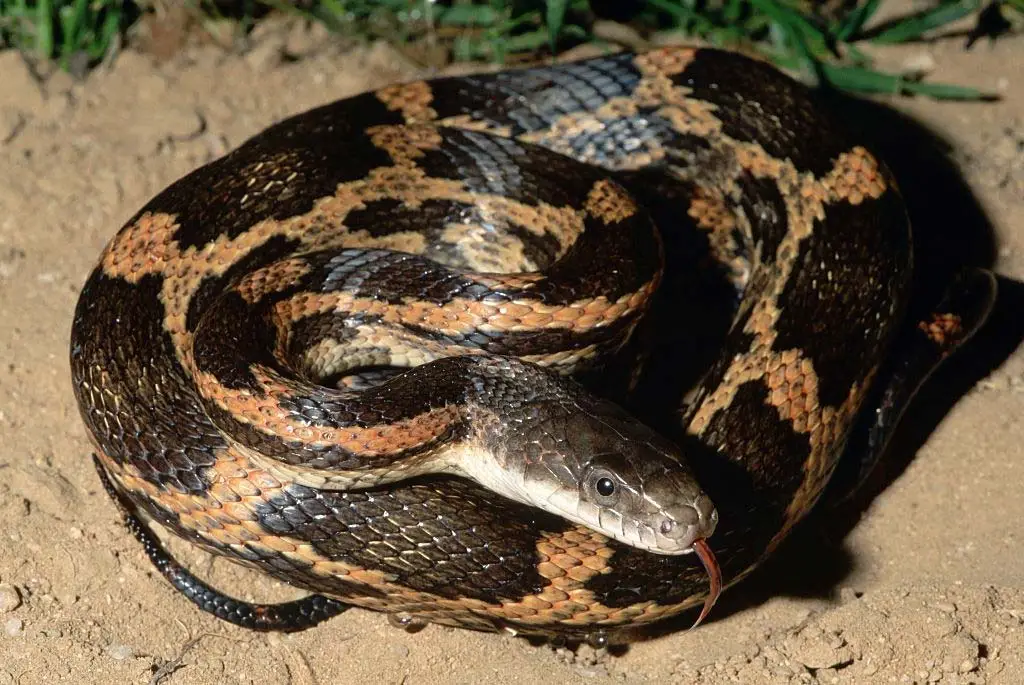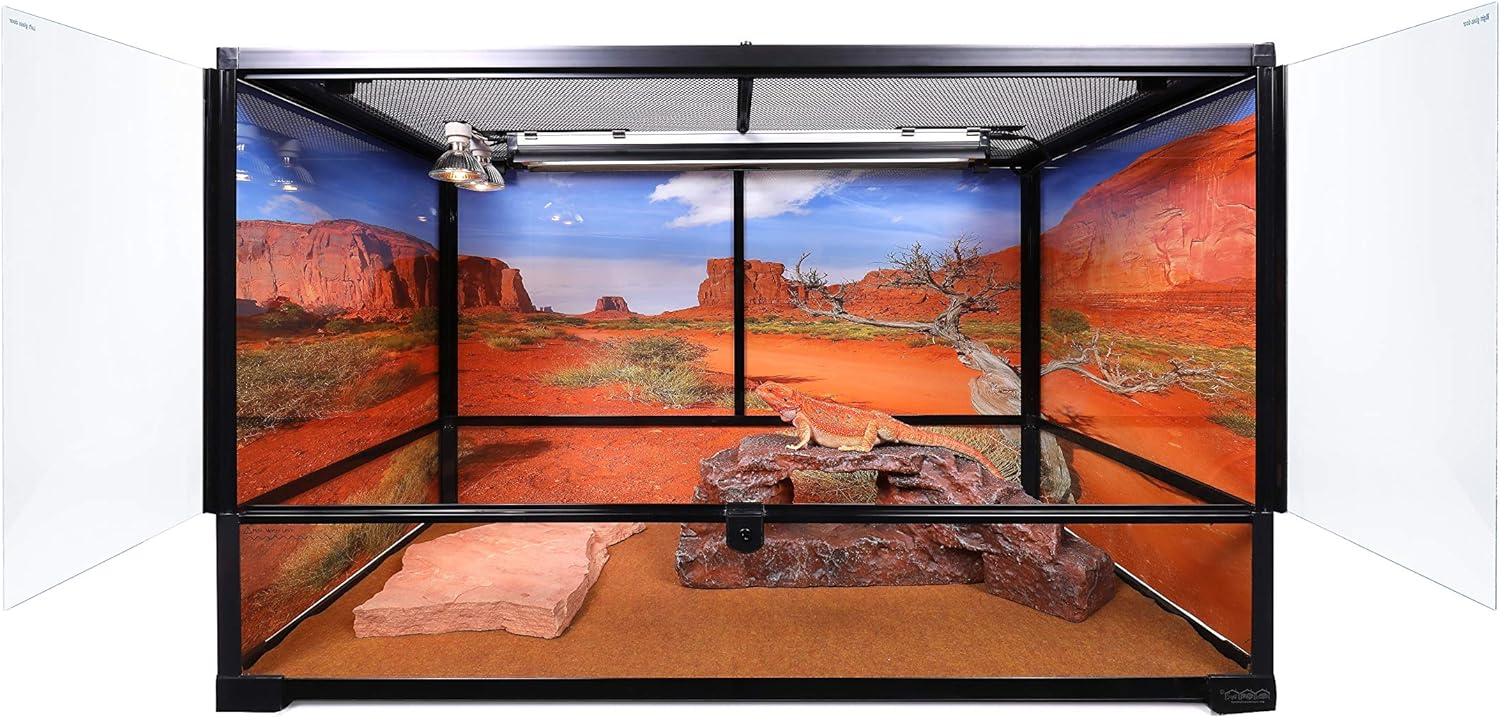One of many rat snakes, the Texas rat snake (Elaphe obsoleta lindheimeri) is notable for its more docile nature and comparatively easy care.
Though it requires a larger enclosure, beginners and experts alike can undoubtedly meet all of the Texas rat snake’s needs.
Its size is matched by its long lifespan and larger personality. This snake takes well to handling and is fascinating to watch as it burrows, forages, climbs, and soaks.
| Common Name: | Texas Rat Snake |
| Scientific Name: | Elaphe obsoleta lindheimeri |
| Natural Habitat: | Originally Texas, but have spread to Louisiana, Oklahoma, & Arkansas |
| Adult Size: | Approximately 4 – 6 feet |
| Lifespan: | 10 – 15 years |
| Diet: | Rodents, reptiles, birds, & eggs |
| Experience Level: | Beginner, intermediate, & expert |
| Enclosure Size: | 50 gallons for adults; 5 – 20 gallons for hatchlings & juveniles |
Reptile Overview
Texas rat snakes are friendly giants. They can grow at long as a human is tall and may have a personality to match.
They are docile with regular handling and make great beginner reptiles. These snakes have straightforward and simple care requirements and aren’t picky eaters.
If properly taken care of, owners will have minimal health issues and can easily breed females if desired.
As they become more popular in the pet trade, more colors are increasingly available. Besides its native neutral tones, owners can also find the Texas rat snake in common morph variations.
Overall, this is a great snake for all reptile owners. Whether you’re new to the reptile trade or are a seasoned professional, the Texas rat snake will undoubtedly bring you years of joy.
If you’re prepared for a larger enclosure, this is the perfect snake for you.
Appearance
Texas rat snakes are a neutral color that can vary depending on their environment. For example, eastern Texas rat snakes are grey, while central Texas rat snakes are more yellow.
Native rat snakes have red or orange skin beneath their scales.
Generally, they have a lighter-colored belly and head, usually white or grey.
They have been seen single-colored and with blotches, stripes, or both.
However, these snakes are becoming increasingly available in morph varieties. Albino, leucistic, and scaleless are just three examples of popular variations.
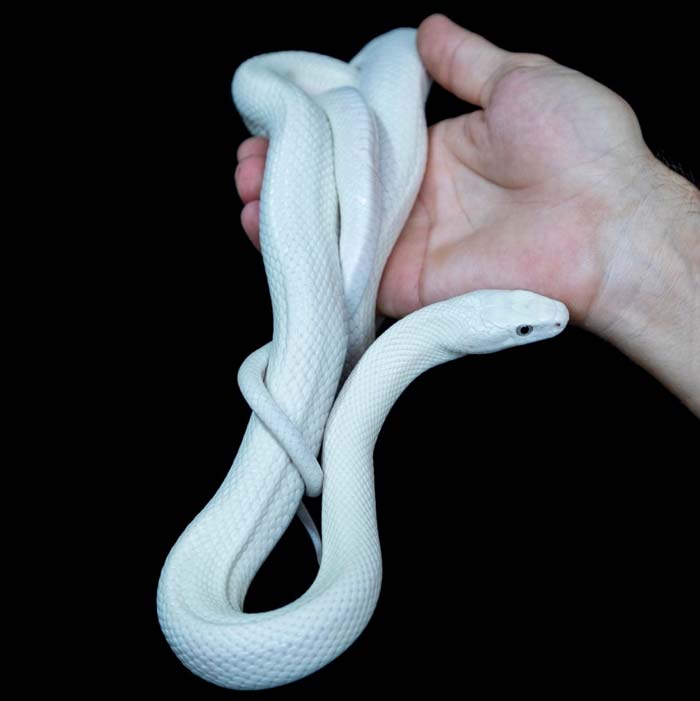
As a hatchling and juvenile, they are roughly one foot in size (12 – 15 inches). Both males and females will grow to approximately four to six feet.
They are long and slender with wedge-shaped heads. Like most nonvenomous snakes, their pupils are a distinct round shape.
They should remain lean throughout their life. If your snake ever becomes broad or thick, they may be obese.
Captive animals are at greater risk of obesity than their wild counterparts. To avoid this, owners should take extra care to monitor their snake’s diet and activity levels.
Behavior & Temperament
This nocturnal species prefers to spend its nights burrowing and foraging. However, it’s not unusual to see them active during the day.
Typical of many snakes, they are frequently found basking and soaking.
While not overly aggressive, these snakes can be defensive.

This is especially true when they’re in their enclosure. After all, you wouldn’t like it if some stranger broke into your home— and your snake feels the same way!
Common defensive behaviors include gaping their mouths and rattling their tails. They may also strike at you.
Texas rat snakes are not venomous, so don’t panic if this happens. They have neither venom nor large fangs.
Lesser known is their ability to produce a musk, similar to skunks. This is more common in juveniles, but adults are still capable of creating some serious stink.
Becoming known to your snake will help reduce defensive behaviors. Building on the metaphor we used above, you’d probably welcome a known visitor (dare we say, a friend?) rather than a random intruder.
To create this connection with your snake, you’ll need to regularly handle them. The more comfortable they become with you, the more they’ll trust you.
Expert Tip: Pick up your snake by sliding your hand underneath their mid-section or within the first third of their body. Reach for them from behind; never reach for them head-on or directly.
When holding your snake, avoid sudden movements.
You should also hold them firmly yet loosely. Don’t pinch, squeeze, or tightly grip your rat snake.
Let them freely move and redirect as necessary. Don’t constrict them or otherwise try to make them stay still.
Besides making them defensive, improperly handling your snake can also physically harm them. You could easily damage one of their fragile vertebrae.
Hatchlings and juveniles are generally more skittish than adults.
However, a rat snake’s level of comfort all depends on their past and how much they’ve been socialized. For example, a well-handled juvenile will be more comfortable than an adult that’s never been handled.
When you first buy or adopt your snake, refrain from handling them. For the first week or two, let them become familiar with their new enclosure and schedule.
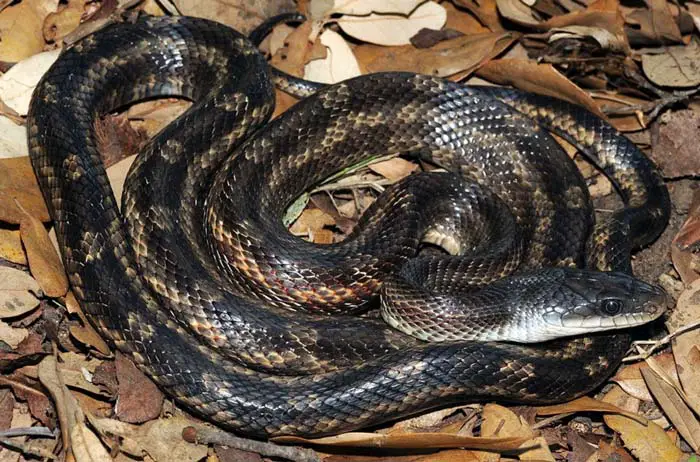
After this, you can begin handling them. A basic handling starter schedule is once per week.
From there, you can judge their comfort level and how often they’ve been handled in the past.
Whether or not you know their history, this is a good schedule to keep as they adjust to you.
As your snake becomes comfortable with you, you can progressively handle them more.
If your snake becomes skittish or defensive, reduce your socialization sessions. Go back to a handling level you know they’re comfortable with.
But being used to handling doesn’t guarantee they’ll never act defensively. They may still strike at you or engage in similar behaviors.
Similarly, buying or adopting a captive-bred Texas rat snake doesn’t guarantee they’ll be docile or used to handling.
Each snake is still an individual. They have their own personality, tolerance/ comfort levels, and stressors.
If they’re behaving defensively, leave them alone. Let them destress and try handling them another day.
Never handle your snake during or after mealtimes or a shed. It’s best to let them rest 12 hours.
Lifespan
Generally, Texas rat snakes live anywhere from 10 – 15 years. There are reports of some individuals living up to 20 years, but these are exceptionally healthy and well cared for.
Enclosure
Adult Texas rat snakes need at least a 50-gallon enclosure. However, they would be happier in a setup with more room.
As a hatchling, five-gallon enclosures will work for the first three or four months. After that, juveniles need at least a 20-gallon enclosure until they are adults.
Carolina Custom Cages Terrarium 36x18x24
You can also use tubs for these snakes. A six-quart tub is fine for hatchlings.
Juveniles will need at least a 28-quart tub, while adults need at least a 41-quart tub.
If you’re using a rack system, make sure the drawer is at least three feet long. It will also need to be deep enough for the rat snake to burrow.
All enclosures should be at least 12 inches high.
This is a lot of space for the substrate and keeps the heat bulbs a safe distance away from the substrate’s surface. Bulbs that are too close can accidentally burn your snake.
Wood shavings are a great option for the substrate. Shredded aspen, cypress, and orchid bark are safe and will not harm your snake’s respiratory system.
Galapagos Aspen Digs Shavings Bedding
Avoid oily, heavy-scented woods like pine and cedar, which can harm your snake and cause breathing problems.
Whatever substrate you use, make sure it allows for burrowing. Aspen is especially good for burrowing since it’s lighter and non-abrasive.
You’ll need at least four inches of substrate, but your snake would appreciate six inches or more.
You’ll need to spot clean the substrate at least once per day. Perform a deep clean at least once per month.
Replace substrate as needed. As you’re cleaning, take advantage of this opportunity and check your snake’s poop to make sure it’s healthy.
Provide plenty of hiding places for your rat snake. There should be at least one hide on the “hot side, one hide on the “cold” side, and one hide in the middle.
For owners who want a more natural setup, you can include grasses, driftwood, logs, and rocks to provide hiding places.
Driftwood and branches are especially appreciated since some rat snakes like to climb. If you add these, make sure they have long, broad sections where the snake can rest.
Whichever type of hiding places and décor you use, make sure they’re relatively light. Heavy hides can collapse burrows and accidentally harm your snake.
You’ll also need to include a water dish or features, such as a fountain or waterfall.
Rat snakes should have 24/7 access to fresh, clean water. Replace or refresh their water daily.
They enjoy soaking, so keep that in mind when choosing a water bowl or feature.
It should be large enough to fit their entire body when curled up. At the same time, it should also be deep enough to allow them to fully submerge their body.
The water should preferably be on the “hot” side or the middle of the enclosure. Cooler temperatures and water can lead to respiratory infections.
Spot check your water dishes and features to make sure no slime or algae has accumulated. Clean them more thoroughly at least once per week.
Sterilize all décor and equipment prior to placing it in the enclosure.
Like many reptiles, these snakes are escape artists. Secure your enclosure with cage clips for the screen top and locks for front-open doors.
Make sure there are no gaps for them to squeeze through. Check areas with equipment that runs from the inside of the enclosure to the outside.
Temperature & Lighting
Since snakes can’t regulate their own body temperature, they rely on their surroundings.
To keep your Texas rat snake comfortable, you’ll need to establish a heat gradient. Luckily, this is much easier with large enclosures.
It may be a struggle in your hatchling or juvenile enclosure, but setting up a gradient for your adult snake will be a breeze.
To create a temperature gradient, you’ll need to pick a “hot” side and a “cold” side. These terms are relative (hence the quotation marks) since the entire enclosure will still be fairly warm.
On the “hot” side, temperatures should be in the mid-80s to low-90s. On the “cold” side, temperatures should be in the mid-to-low-70s.
You can measure the temperatures by placing a thermometer on each side of the tank or tub.
Zoo Med Labs Digital Hygrometer and Thermometer
The easiest way to establish a gradient is to place a light and heat bulb on the “hot” side of the tank.
As your snake travels farther away from the light and heat bulbs, the temperature will drop. This creates the “cold” side.
Another great way to heat your terrarium is under-tank heating pad that is controlled with a thermostat under a third of the tank.
VIVOSUN Reptile Heat Mat with Digital Thermostat
Once established, your snake can move around the tank to warm up or cool off as they please.
During the night, temperatures can drop up to ten degrees, but no lower than 65 degrees Fahrenheit.
You can let this happen naturally by turning off the lights or by buying a lower wattage night bulb.
When picking out a night bulb, make sure to choose one that’s blue or purple.
There’s evidence that reptiles process daylight and red light similarly. This means that red bulbs don’t create a darker (or restful) atmosphere.
To learn more about this sensitivity, check out these sources on the evolution of snake vision, nocturnal color vision, and dim-light vision pigments.
To put it in context, how would you like it if someone left the lamps on all night? Your sleep wouldn’t be as long, deep, or peaceful.
Keep in mind, there is comparatively little research on snake vision as compared to research on other reptiles. Whereas geckos and even turtles have been more extensively studied, we’re still learning about snakes.
Bulbs should be kept at least six inches away from the surface of your substrate. Any closer and they can burn your snake when they’re not burrowing.
Mimicking a regular and seasonal light cycle helps with snakes’ overall health and encourages regular feeding.
You can provide 12 hours of light per day or place your snake on a seasonal light cycle. If you want to do this, shorten the amount of light to 10 hours per day during the fall and winter.
Automatic light timers, like Zilla Digital Timer, can keep track of the hours for you. This keeps your snake on a reliable schedule without tying up your schedule.
When combined with lowered temperatures, a seasonal light cycle may trigger a brumation response. Whereas warm-blooded animals hibernate, cold-blooded animals like reptiles enter brumation.
Brumation is marked by a loss in appetite and extreme lethargy. Their metabolism slows down and you likely won’t see them outside of their hides.
This lasts throughout the cold months. When spring comes, you can slowly bring them out of brumation over the period of one week.
Humidity
Texas rat snakes don’t need high levels of humidity. Typically, they like their enclosures to have between 30 – 50% humidity.
The exception to this rule is when they begin a shed cycle. When they’re shedding, your snake will appreciate higher humidity levels around 60%.

If you notice dull scales, cloudy eyes, and more timid behavior, your snake is likely beginning its shed cycle.
Up the humidity and watch their behavior over the next few days.
If you don’t already have a humid hide in their enclosure, then it’s time to add one.
The humid hide should be closer to the “hot” side of the tank. Remember, cooler temperatures and moist environments aren’t a great mix.
Sphagnum moss is a great way to maintain humidity in hide boxes. You can also use damp paper towels or washcloths.
Galápagos Terrarium Sphagnum Moss
Diet
Texas rat snakes can be fed exclusively with rodents like mice or rats.
Adults need to be fed at least once per week. Rats are the most common source of food.
If your snake isn’t interested in feeding this often, try switching to every other week.
Hatchlings and juveniles need to be fed at least twice per week. It’s best to feed them mice until they grow larger.
You can purchase rodents live or frozen (i.e., dead). Both have pros and cons.
Live rodents encourage a heartier appetite and are closer to what your snake would eat in the wild. However, they also pose a danger and can hurt your snake during the feeding process.
Conversely, it can be harder to get snakes to eat frozen rodents, even after they’ve been thawed. But they don’t pose a safety risk and there’s no risk of them carrying diseases.
To better entice your snake, heat up frozen prey until it’s closer to a natural body temperature. This means slightly above room temperature.
You can also wiggle prey around to make it seem like it’s still alive. This movement will attract your rat snake more than rodents that lay still.
For very picky eaters, try dabbing a bit of tuna or salmon juice on the rodent. Though doing this too often will make snakes dependent on it, it’s okay to do it every once in a while.
‘Braining’ the rodent is a better, albeit messier, way to add scent. This involves poking a hole through the rodent’s skull and squeezing some brain matter out.
If you want to emulate a more natural diet, mix in a variety of other foods with the rodents. Lizards, small reptiles, birds, and eggs are all examples of food your snake would eat in their native habitat.

Whether you feed your snake strictly rodents or a more natural mixture, remember that they’re carnivores. They won’t appreciate it if you drop fruits or veggies in their enclosure.
Texas rat snakes are a foraging species, so you don’t have to give them all their food directly. Instead, you can hide supplemental food throughout their enclosure and watch them root it out.
Expert Tip: Prey should never be larger than the widest part of your snake.
Use proper equipment when feeding your snake, such as tongs.
unlumm Feeding Tongs 15″ 2 Pcs
Never feed your rat snake with your hands.
This will prevent unnecessary injuries to you and your snake. It will also prevent them from associating your hands with food, which can lead to hungry bites in the future.
When they eat, rat snakes strike at food and then constrict it.
While they’re digesting, it’s normal to see a slight bulge. But your snake’s stomach shouldn’t be distended or still have a bulge after 12 hours.
If your snake regurgitates its food, either something is wrong with the food or your snake is stressed out and doesn’t feel safe.
Remove the food, critically examine any other rodents, and monitor your snake’s behavior. Try to feed them again after 24 hours.
If the problem persists, contact your veterinarian.
Potential Health Issues
The easiest way to spot potential health issues is to understand what a healthy snake looks like.
Your Texas rat snake should have clear eyes, a clear nose and mouth, and healthy skin. It should be alert, active, and eating regularly.
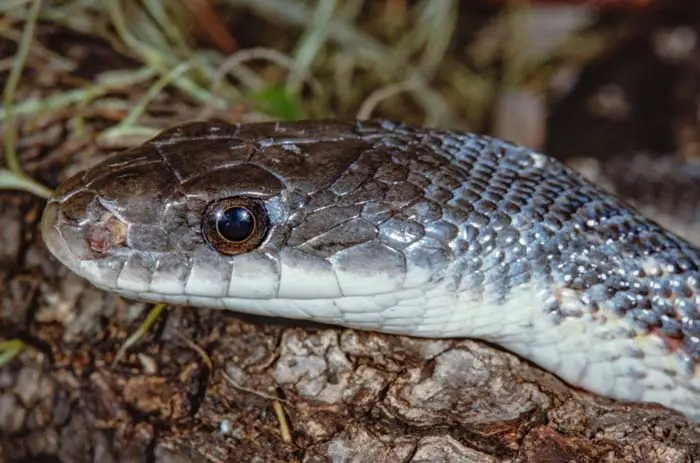
Look out for changes, such as bubbles or discharge around the nose or dull, wrinkled skin. If you see anything that isn’t normal and/or healthy, it’s time to start investigating.
Fungal and respiratory infections are common health problems owners encounter. Breathing with its mouth open, wheezing, or panting are all dependable signs that something is wrong.
Discolored skin can also point to an infection.
Stomatitis (also known as mouth rot) is also common amongst rat snakes. It happens when open mouth wounds become infected with bacteria, causing issues with the gums, mouth, and digestive tract.
Symptoms includes swelling in the mouth, color changes in the gums, and your snake frequently opening or rubbing their mouths.
If your husbandry isn’t up to par, you may also have to contend with shedding problems, blister disease, and mites.
If you suspect your snake is sick, contact a reptile-licensed veterinarian. Schedule an appointment as soon as possible.
Preventative care like regular vet check-ups and home inspections can help you identify potential health issues before or soon after they appear.
Breeding
If you want to mate your Texas rat snake, the first thing you need to do is confirm she’s at least two years old.
After that, you’ll need to induce brumation (which we discussed earlier). Once this is complete and late “spring” has come, she’ll be ready for breeding.
Pregnancy lasts approximately five weeks. When your snake is ready to lay her eggs, she’ll find a quiet and secluded spot.
You can provide a specialized pregnancy hide or let her choose a spot, provided your enclosure closely mimics her natural habitat.
Texas rat snakes can lay up to two clutches per year, with each clutch containing up to 20 eggs.
It will take roughly two months for the eggs to hatch. Your snake won’t have any maternal instincts, so it’ll be up to you to care for the newborns.
Conclusion
Texas rat snakes are a wonderful species for all reptile owners, new and old alike. Though their size and enclosure requirements can be initially daunting, their easy care and docile personality quickly overcome owners’ uncertainty.
These snakes are active both above and below ground. Over the course of the day and throughout the night, you’ll see them engage in a wide variety of activities.
They love soaking and climbing just as much as they enjoy burrowing and foraging. For owners looking for a more lively snake, these are a wonderful choice.
Related:

